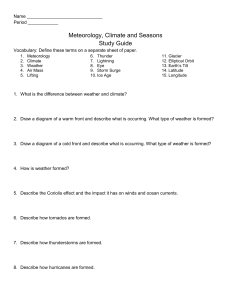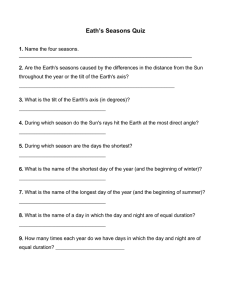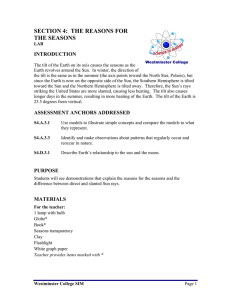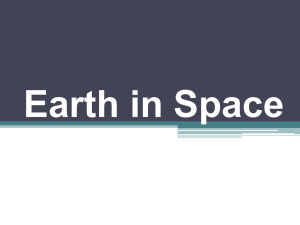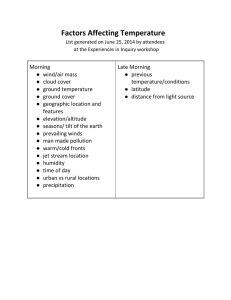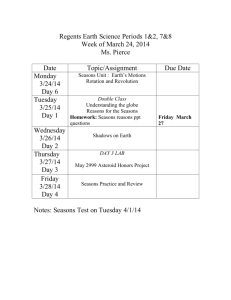Seasons When & why is it hot and cold - Section...
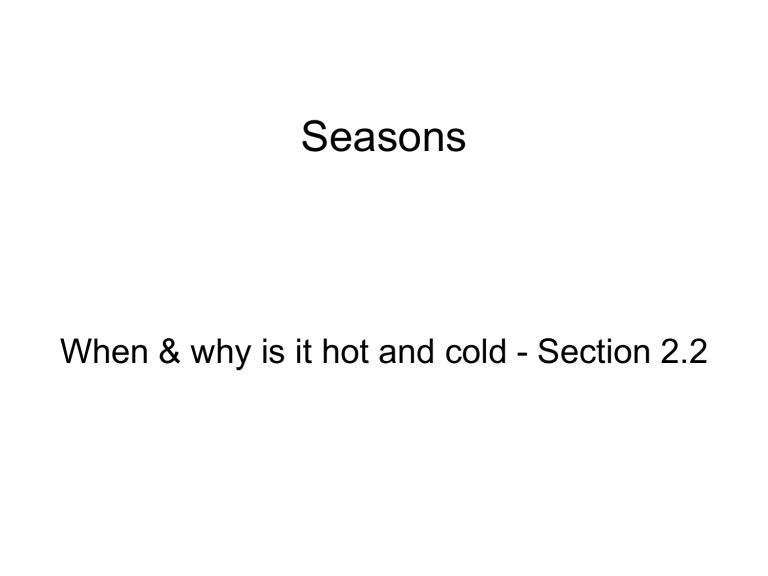
Seasons
When & why is it hot and cold - Section 2.2
Learning Outcomes, Objectives, & Goals
• Appreciating science in general, and astronomy in specific.
• Understanding how knowledge is gained and be critical of what you see and hear.
• Developing a working knowledge of the scientific method and how to apply it to real world situations.
• Critically analyzing and evaluating information, scientific or otherwise
• Learn some simple astronomical nomenclature/terminology.
• Develop a sense of what scientists know about the overall universe, its constituents, and our location
• Explain the causes of seasonal variations in the length of the day, the direction of sunrise and sunset, and the amount of solar heating.
Overarching questions
• What causes it to be hot and cold?
• What things could cause temperature differences?
• What causes Earth summer / winter?
• How is the Earth’s tilt related to seasons, if at all?
• What info would you need to know to predict “seasons” on other planets?
• What is precession?
REMINDER: Planet temperature
Depends on two things:
1. Amount of energy absorbed (warm up)
2. Amount of energy emitted (cool off / down)
Absorption of visible light
Which absorbs more sunlight? Air or water/ground? How do you know?
Things that affect amount of light absorbed:
1. Distance to Sun
2. Color of ground (black vs. white)
– Look at the map on page 40. Which is better at absorbing visible light - Water or ground?
Clicker
– (technical note IR “color” is important too. Why?)
– We won’t talk about color anymore. Climate and weather models need to account for it; we don’t.
3. Exposure time in sunlight (daytime length)
0
0
Which is better at absorbing visible light from Sun? (see picture on p 40 first)
1. Water
2. Ground
After finishing this slide, finish the previous slide.
1 2 3 4 5 6 7 8 9 10 11 12 13 14 15 16 17 18 19 20
21 22 23 24 25 26 27 28 29 30 31 32 33 34 35 36 37 38 39 40
41 42 43 44 45 46 47 48 49 50 51 52 53 54 55
Distance
Many people think seasons are caused by the distance to the Sun.
We’re good scientists now, so what should we do?
Let’s test this idea!
• BESIDES temperature, predict an observation we could make from Earth associated with the distance to the Sun
• Predict what we would observe.
– The Sun will look bigger during _______ and ….
• Write your prediction down in a place you can cover up. Again, leave a place for the correct answer that you can cover up.
Movie – coming soon to web page
Distance to Sun
• Closest to Sun = peri helion
– January 3
• Furthest from Sun = ap helion
– July 4
• On EARTH, difference between nearest and furthest is
“small” (3.4%)
(3 million miles or 5 million km)
– Only noticeable using careful pictures. Not without.
• Compare that to the size of the entire Earth:
Radius of Earth is ___________.
Lecture tutorial , pages 91-92. Tell them answer to #3.
0
0
0
0
Who did you agree with on the bottom of page 92?
1. Student 1
2. Student 2
3. Both
4. Neither
1 2 3 4 5 6 7 8 9 10 11 12 13 14 15 16 17 18 19 20
21 22 23 24 25 26 27 28 29 30 31 32 33 34 35 36 37 38 39 40
41 42 43 44 45 46 47 48 49 50 51 52 53 54 55
Time absorbing visible light
• Is it true that there is MORE time to absorb visible and IR sunlight during SUMMER? Why?
• Is it true that there is LESS time to absorb … during
WINTER? Why?
• At night, is the Earth heating up or cooling off?
How?
• Does the cooling time difference strengthen or weaken the idea that summer is hot because of longer days AND shorter nights?
• We’ll focus on daytime from now on. Nighttime arguments yield the same results.
Daytime length
• Our next question:
– Why are daytime and nighttime lengths different at different places?
Daytime / nighttime & seasons
It appears we have a good explanation. Our temperature observations are explained.
Daytime length also explains why north & south seasons are opposite.
The CAUSE of different times = tilt of Earth. You may already have heard the tilt causes the seasons.
Before we draw our conclusion, a good scientist will do what to their newly considered hypothesis?
• Test it!
• Is there anyplace on Earth that gets prolonged sunlight during some part of its year?
• What’s the temperature like there?
• Is the daytime length the only important effect for hot/cold?
• It is important for us
. But it’s not the MOST important thing for hot vs. cold or for summer vs. winter!
Season causes – what’s dominant?
So, we’ve ruled EVERYTHING out as the dominant effect!?!?!
1. Earth-Sun Distance is “backwards” for people in US
2. Earth’s color doesn’t change much month-to-month
3. Daytime / nighttime doesn’t explain tropical & polar weather at any time of year, but … it partly explains hot summer / cold winters for middle-latitudes.
RECALL: the different day/night times were caused by …
Obviously we’ve missed something if we want a complete picture – why it’s hot and cold at different places at different times….
Let’s observe carefully as we travel to other parts of the world during different seasons.
Let’s look at the Sun from the north pole, LA, and the equator. *demo*
• Aside from “always” being up, what do we notice about Santa’s Sun?
•
In LA, how is that different?
California Elementary School
Science Standards for seasons
• From California Science Standards, grade 3
– Students know the position of the Sun in the sky changes during the course of the day and from season to season
.
– Students know the patterns of stars stay the same, although they appear to move across the sky nightly, and different stars can be seen in different seasons
.
Sun location & temperature
Why does Sun location affect the amount of sunlight we absorb? Let’s examine…
• Imagine a light bulb in the center of the room & your paper = ground. Make your ground catch the most sunlight.
• Standing on this ground, which direction is the Sun?
• Conclusion:
– When the Sun is high in the sky, the ground faces the Sun!
• Is this going to be a big effect or small effect? Why?
Work on Lecture Tutorial, page 93 ONLY
0
0
0
When is the Sun directly overhead here in LA?
1. Every day at noon
2. Only during summer
3. Never
1 2 3 4 5 6 7 8 9 10 11 12 13 14 15 16 17 18 19 20
21 22 23 24 25 26 27 28 29 30 31 32 33 34 35 36 37 38 39 40
41 42 43 44 45 46 47 48 49 50 51 52 53 54 55
Sun is far away to the left
Shade your Earth appropriately.
Is ground A directly facing the Sun?
Is the Sun high in the sky, midway, or low?
Will ground A be hot, medium, or cold?
Is ground B directly facing the Sun?
Is the Sun high in the sky, midway, or low?
Will ground B be hot, medium, or cold?
Put a dot on the ground directly facing the Sun
What would weather be like there?
C
B
Earth day
A night
Which is hotter, C or the equator?
Which hemisphere is hotter: north or south?
(Clicker)
0
0
0
Ask your neighbor: Which hemisphere is hotter?
23 °
1. North
2. South
23 °
3. Cannot be determined day night
Earth
23 °
23
°
1 2 3 4 5 6 7 8 9 10 11 12 13 14 15 16 17 18 19 20
21 22 23 24 25 26 27 28 29 30 31 32 33 34 35 36 37 38 39 40
41 42 43 44 45 46 47 48 49 50 51 52 53 54 55
0
0
0
Ask neighbor: Is everyplace in that hemisphere hot at noon?
23 °
Earth 1. Yes
2. No
23 °
3. Cannot be determined day night
23 °
It’s still called “summer” for the ENTIRE hemisphere, even though some places are cold.
23
°
1 2 3 4 5 6 7 8 9 10 11 12 13 14 15 16 17 18 19 20
21 22 23 24 25 26 27 28 29 30 31 32 33 34 35 36 37 38 39 40
41 42 43 44 45 46 47 48 49 50 51 52 53 54 55
Two pictures
• The next slide shows how the Earth looks on 2 important dates.
Looking from one side
NEIGHBOR: On this left-side drawing, which hemisphere has summer? How can you tell?
Where is the Sun directly overhead in this drawing?
Name __________
Copy this drawing into your notes
LA
LA day Sun night night day
Where is the Sun directly overhead in this drawing?
Name __________
NEIGHBOR: On this drawing, which hemisphere has summer? How can you tell?
This date is June 21
This date is Dec 21
Lecture Tutorial
• Work on Pages 94-96 for practice.
0
0
0
0
0
What season is it for D?
1. Summer
2. Winter
3. Spring
4. Fall
5. Cannot be determined day
D night
1 2 3 4 5 6 7 8 9 10 11 12 13 14 15 16 17 18 19 20
21 22 23 24 25 26 27 28 29 30 31 32 33 34 35 36 37 38 39 40
41 42 43 44 45 46 47 48 49 50 51 52 53 54 55
Season start dates & what happens
You should be able to convince yourself that the seasons are opposite in the northern & southern hemispheres. You should also understand why.
•
March 21 = equinox. In LA = Spring. (Vernal equinox)
– First official day of spring (in north)
– Where is the Sun straight up?
– Why do you think it’s called an equi-nox?
See also pages
38-39
• June 21 (6/21)= solstice. In LA = summer solstice. How about in
Australia?
– First official day of summer (in north)
– Where is the Sun straight up?
– What happens inside the Arctic circle? Antarctic circle?
• September 21 = equinox. In LA = Fall (Autumnal equinox).
– First official day of fall (in north)
– Where is the Sun straight up?
– Why do you think it’s called an equi-nox?
• Dec 21 = solstice. In LA = winter solstice. How about in Australia?
– First official day of winter (in north)
– Where is the Sun straight up?
– What happens inside the Arctic circle? Antarctic circle?
Now you’re ready for the test
• But just in case…
• Try the Seasons Ranking Tasks handout for homework(?) or practice (outside of class).
Precession
See pages 41-42 in textbook for this topic.
You’ve probably noticed that the sky has changed a little over the last
2000 years. (Birthday game) The ancients knew about this, but it did take several hundred years of observations to figure it out.
As we’ve discussed before, the Earth’s rotation axis is tilted 23.5° away from its revolution axis around the Sun.
The amount of this tilt doesn’t change. The direction of this tilt, however, does. It wobbles in a circle once every 26,000* years.
*A more exact number is 25,771.5 years.
Over 2000 yrs this slow wobble causes a slight change in the zodiac constellations. This is why your “sign” is probably 1 sign earlier.
Precession has NOTHING TO DO WITH SEASONS.
Precession: 26,000 yr cycle!
Seasons: 1 yr cycle!
What’s Your Sign? Then & Now
Constellation 2000 yrs ago (divided equally) Now Days Sun in the sign
Capricorn US
Aquarius
Dec 22 - Jan 19
Jan 20 - Feb 19
Jan 19 - Feb 16
Feb 16 - Mar 12
28
24
Pisces
Aries
Taurus
Gemini
Cancer
Leo
Virgo
Libra
Scorpi US
Feb 20 - Mar 20
Mar 21 - Apr 19
Apr 20 - May 20
May 21 - June 20
June 21 - July 22
July 23 - Aug 22
Aug 23 - Sep 22
Sep 23 - Oct 22
Oct 23 - Nov 21
Mar 12 - Apr 19
Apr 19 - May 14
May 14 - June 21
June 21 - July 21
July 21 - Aug 11
Aug 10 - Sep 17
Sep 17 - Oct 31
Oct 31 - Nov 23
Nov 23 - Nov 30
Ophiuchus
Sagittarius
Not part of zodiac
Nov 22 - Dec 21
Nov 30 - Dec 18
Dec 18 - Jan 19
19
32
Info from Wikipedia's article about the Zodiac, subtopic: Precession of the Equinoxes.
This info is on the course website.
21
37
44
23
7
38
25
38
30
Overarching questions
• What causes it to be hot and cold?
• What things could cause temperature differences?
• What causes Earth summer / winter?
• How is the Earth’s tilt related to seasons, if at all?
• What info would you need to know to predict “seasons” on other planets?
• What is precession?

